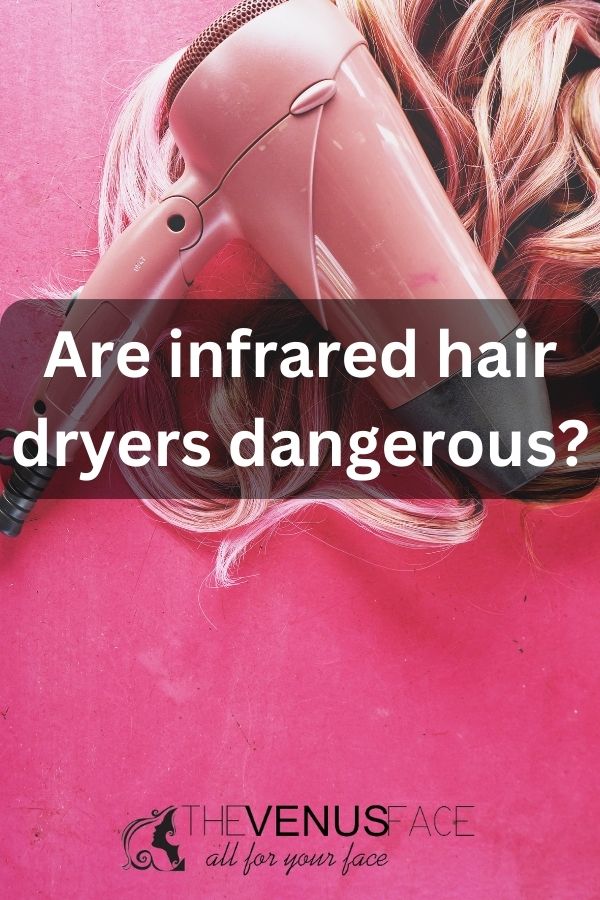In recent years, there has been a growing fascination with the potential benefits of infrared hair dryers in the world of hair care and styling. These innovative devices claim to provide faster drying times, reduced damage to hair, and even therapeutic effects on the scalp. However, as with any emerging technology, questions about safety and potential risks have emerged. Are infrared hair dryers truly safe to use, or do they pose hidden dangers to our hair and scalp health? Are infrared hair dryers dangerous? In this exploration, we delve into the world of infrared hair dryers to examine their benefits, potential risks, and whether the allure of quick, efficient drying might come at a cost to our hair and well-being.

Are infrared hair dryers dangerous?
Infrared hair dryers are generally considered safe for use. They utilize infrared technology to emit gentle, radiant heat that penetrates the hair shaft, resulting in faster and less damaging drying. While concerns have been raised about electromagnetic field (EMF) exposure from hair dryers, it’s important to note that most household appliances, including hair dryers, emit low-frequency EMFs that are not considered dangerous to human health. Hair dryers emit very little radiation and do not harm molecules in the human body, making them safe for regular use. However, if you have specific concerns about EMF exposure, you can opt for low-EMF hair dryers, which are designed to minimize EMF emissions.
How much EMF do you get from a hair dryer?
The electromagnetic fields (EMF) emitted by hair dryers can vary, but they generally fall into the category of low-frequency EMFs. Low-frequency EMFs are typically considered safe for human exposure. The strength of EMFs from hair dryers is measured in milligauss (mG), and the levels can range from around 1 mG to 700 mG depending on the specific hair dryer model and its settings.
It’s important to note that hair dryers are not among the devices known for emitting high levels of EMFs. The EMF levels from hair dryers are considered low and are not typically a cause for health concerns. However, if you are particularly sensitive to EMFs or have specific concerns, you can look for hair dryers marketed as “low EMF” or “EMF-free,” which are designed to minimize EMF emissions even further.
More: Best Teflon-Free Blow Dryers
What are the cons of infrared hair dryers?
Infrared hair dryers offer several benefits, such as faster drying times and reduced damage to hair, but they also have some drawbacks:
- Cost: Infrared hair dryers can be more expensive than traditional hair dryers, making them less budget-friendly for some users.
- Weight and Size: Some infrared hair dryers are bulkier and heavier than standard models, which can be less comfortable to use for extended periods. More: Most lightweight hair dryers for arthritis.
- Complexity: Infrared hair dryers often come with multiple settings and features, which may be confusing for those who prefer a simple and straightforward drying experience.
- EMF Emissions: Like many electrical appliances, infrared hair dryers emit low-frequency electromagnetic fields (EMFs). While there’s no conclusive evidence of harm, concerns about prolonged exposure to EMFs exist.
- Availability: Infrared hair dryers may not be as widely available as traditional models, limiting options for consumers.
- Learning Curve: Using an infrared hair dryer effectively may require some adjustment, as the drying process can feel different compared to traditional dryers.
- Maintenance: Some infrared models have specific maintenance requirements, such as cleaning or replacing infrared bulbs, adding to the overall cost of ownership.
Does infrared heat damage hair?
Infrared heat is generally considered safe for hair and can even offer some benefits. Unlike traditional direct heat sources, such as curling irons or flat irons, which can cause damage by overheating the hair shaft, infrared heat works differently.
Here’s why infrared heat is less likely to damage hair:
- Gentle Heat: Infrared heat emits a gentle, radiant warmth that penetrates the hair without excessively drying it out or causing immediate damage.
- Improved Blood Flow: Infrared heat can stimulate blood circulation to the scalp, which may promote hair growth and overall hair health.
- Moisture Retention: Infrared heat is less likely to strip the hair of moisture, helping to maintain its natural hydration.
- Reduced Friction: It reduces friction and prevents hair from becoming overly dry, frizzy, or brittle.
- Lower Risk of Burns: Infrared saunas and hair tools are designed to provide consistent and controlled heat, reducing the risk of burns or hot spots on the hair.
While there is a minimal risk of any heat source causing damage if used excessively or improperly, infrared heat is generally considered safer for hair than many other forms of heat styling. However, it’s essential to use any heat source in moderation and take proper precautions to protect your hair, such as using heat-protectant products and not exposing your hair to excessive heat.
More: Why Is My Blow Dryer Not Getting Hot?
Is a hair dryer radiation conduction or convection?
A hairdryer primarily uses convection to dry hair. Here’s how it works:
Convection: The hair dryer has a heating element that heats the air inside it. As the air gets hot, it becomes less dense and rises. This rising hot air surrounds wet hair, causing moisture on the hair’s surface to evaporate. This process of hot air rising and carrying away moisture is convection.
Forced Convection: The hair dryer also employs forced convection. A small motor inside the hair dryer forces air out of the device at a high velocity. This forced airflow enhances the drying process by quickly carrying away moisture from the hair’s surface. Forced convection is the result of mechanical action.
Radiation: While radiation is a mode of heat transfer, it is not the primary mechanism in hair dryers. Hair dryers primarily rely on convection and forced convection to dry hair. Radiation, which involves the transfer of heat through electromagnetic waves, is not a significant factor in the hair-drying process.
Conclusion
Are infrared hair dryers dangerous? Infrared hair dryers offer benefits such as faster drying and reduced damage. They emit low EMFs, generally safe for use, with low-EMF options available. However, cons include cost, size, and complexity. Infrared heat is gentler on hair, promoting blood flow and moisture retention, but responsible usage is key to preventing damage. Overall, infrared hair dryers provide a safer and potentially beneficial hair care option, with considerations for their pros and cons essential for users.


